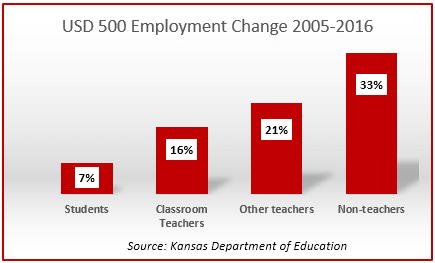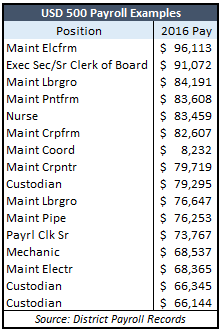The Kansas City Star rang in the New Year with a media bias trifecta in their relentless push for higher taxes and more government spending. They withheld information that contradicts claims made in the story, chose not to interview anyone who doesn’t believe school funding should increase and they threw in a false claim for good measure.
The poverty issues referenced in the Kansas City, Kansas school district are real and must be addressed, but the Star acts as a public relations office for the district by pushing a false choice on readers: government officials say they need more money and the bad guys in the Legislature won’t pony up, so readers should join the push for higher taxes. And media wonders why so many people have lost trust.
False claim to generate sympathy
The story falsely claims that “…the court ordered that more money be given to districts such as Kansas City, Kan., to help equalize funding with wealthier districts such as Blue Valley, Olathe and Shawnee Mission.” No matter how many times media and school officials make this claim, it’s still false. The Supreme Court was very clear in its March 2014 ruling, saying “We agree that the infirmity can be cured in a variety of ways—at the choice of the legislature. And the legislature should have an opportunity to promptly cure. Any cure will be measured by determining whether it sufficiently reduces the unreasonable, wealth-based disparity so the disparity then becomes constitutionally acceptable, not whether the cure necessarily restores funding to the prior levels (emphasis added).” This form of media bias is also a political swipe at legislators who don’t wave the just-spend-more flag and whom the Star routinely opposes on its editorial pages.
Facts withheld from readers
The spending numbers cited were accurate, but a great deal of information refuting claims that funding was inadequate and/or more money is needed to address educational issues was withheld from readers; that’s another form of media bias.
For example, USD 500 Kansas City used $41.9 million of state and local tax aid provided since 2005 to increase their operating cash reserves from $25.5 million to $67.4 million. They added $7.1 million just last year. District officials could choose to spend aid they didn’t need in prior years rather than sue taxpayers for more. The district also used discretionary funding to hire those lawyers to sue citizens for more money rather that spend it on students. And while the State is supposed to have a 7.5 percent ending reserves each year, the Kansas City district boosted their operating reserve from 12.9 percent going into the 2006 school year to 22.7 percent for the 2016 school year.
Per-pupil funding jumped 45 percent since 2005 (while inflation was 22%), going from $9,995 to $14,523 but district officials chose to reduce the share of spending allocated to Instruction while doubling the share for Capital and Debt; barely 50 percent of the $298 million spent last year was allocated to Instruction.
 And with just a 7 percent increase in enrollment since 2005, district employment jumped by 24 percent, including a 33 percent hike in non-teacher staff. Historical enrollment and employment data downloaded from the Department of Education website shows USD 500 has a manager for every 135 students, while the Shawnee Mission district has a manager for every 206 students; at the Shawnee Mission ratio, Kansas City would have 52 fewer managers and free up millions for other functions.
And with just a 7 percent increase in enrollment since 2005, district employment jumped by 24 percent, including a 33 percent hike in non-teacher staff. Historical enrollment and employment data downloaded from the Department of Education website shows USD 500 has a manager for every 135 students, while the Shawnee Mission district has a manager for every 206 students; at the Shawnee Mission ratio, Kansas City would have 52 fewer managers and free up millions for other functions.
Efficiency audits identified many opportunities for the district to save money, but many of those recommendations seem to have been ignored. For example, Kansas City was cited for paying 20 percent to 30 percent above market wages  for maintenance and operational positions but their 2016 payroll listing still shows highly-paid maintenance staff, including a $96,113 electrician foreman, two carpenters making more than $80,000, an executive secretary paid $91,072, a payroll clerk making $73,767, one custodian paid $79,295 and two others paid over $66,000.
for maintenance and operational positions but their 2016 payroll listing still shows highly-paid maintenance staff, including a $96,113 electrician foreman, two carpenters making more than $80,000, an executive secretary paid $91,072, a payroll clerk making $73,767, one custodian paid $79,295 and two others paid over $66,000.
In addition to the usual cadre of Assistant Superintendents, Directors and other executives, Kansas City may be the only district where the Superintendent has her own Chief of Staff. David Smith was paid $134,689 last year and his title on the 2016 Open Records request was changed to “Adm Staff” but he was listed as Chief of Staff in prior years.
The complete Kansas City district payroll for 2016 and several prior years can be found here; amounts listed do not include benefits.
Opposing Views Not Permitted
Only reporting the opinions on one side of a story is another version of media bias. In this case, the Star shared the views of five people who believe funding must be increased but no opposing views were permitted. Alan Rupe, one of the taxpayer-funded school lawyers, was quoted as were two district employees, a lobbyist for the Kansas Association of School Boards and someone representing an advocacy group that opposed the re-election of legislators who didn’t support large school funding increases. They are each entitled to their opinions but in choosing not to balance the story with opposing viewpoints, media puts a very heavy thumb on one side of the scale.
Holding Media Accountable
This is but the latest example of media bias; another one pushing an $820 million tax increase is documented here and this piece documents a collection of media misrepresentations.
But come January 30, there will be a new online service to hold government and media accountable. The Sentinel is a standalone 501(c)3 non-profit service (full disclosure: KPI employees hold two of the five board seats) with a dream team of investigative journalists. Veteran journalists Jack Cashill and Danedri Herbert will launch the service and they hope to add more reporters as funding increases.
Hawver’s News Service recently reported that The Sentinel already has the attention of Topeka statehouse press corps and says “…reporters will be looking over their shoulders.” In the interest of a better-informed public, that’s a good thing.




